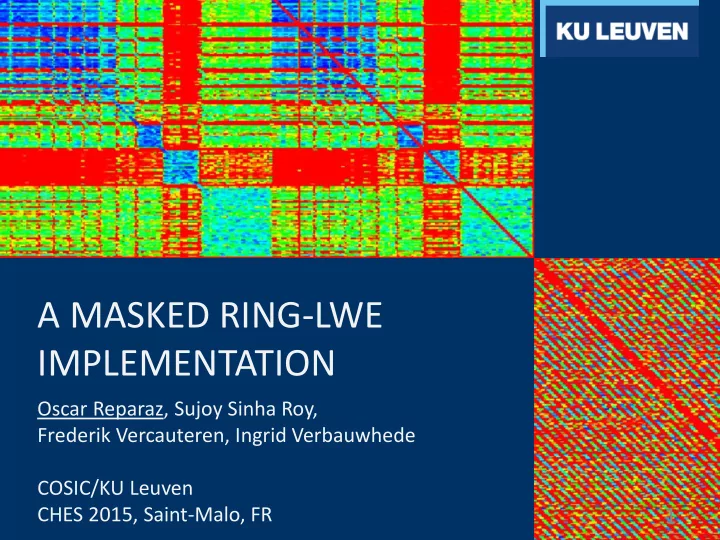

A MASKED RING-LWE IMPLEMENTATION Oscar Reparaz, Sujoy Sinha Roy, Frederik Vercauteren, Ingrid Verbauwhede COSIC/KU Leuven CHES 2015, Saint-Malo, FR 1
un protected ring-LWE decryption r2 m=th[INTT(c 1 *r 2 + c 2 )] 2
un protected ring-LWE decryption r2 c1 c2 m=th[INTT(c 1 *r 2 + c 2 )] 2
un protected ring-LWE decryption r2 x x x x x x x x x x c1 c2 m=th[INTT(c 1 *r 2 + c 2 )] 2
un protected ring-LWE decryption r2 x x x x x x x x x x c1 + + + + + + + + + + c2 m=th[INTT(c 1 *r 2 + c 2 )] 2
un protected ring-LWE decryption r2 x x x x x x x x x x c1 + + + + + + + + + + c2 INTT m=th[INTT(c 1 *r 2 + c 2 )] 2
un protected ring-LWE decryption r2 x x x x x x x x x x c1 + + + + + + + + + + c2 INTT th th th th th th th th th th m m=th[INTT(c 1 *r 2 + c 2 )] 2
th operation 3
masking ring-LWE • Core idea: split the secret: r= r’+r’’ m=th[INTT(c 1 *r 2 + c 2 )] 4
masking ring-LWE • Core idea: split the secret: r= r’+r’’ 1 2 2 m=th[INTT(c 1 *r 2 + c 2 )] 4
on the masked decoder 1 2 2 6
on the masked decoder 1 2 2 6
7
7
7
7
what happened? • could decode th (a) from quad(a’) and quad(a’’) – quad() return only 2 bits, so it will be easy to perform masked computation. • Idea: decode th (a) only from quad(a’) and quad(a’’) – large compression 8
decoding rules • There are 7 other more cases (“rules”) • There are 8 cases that don’t allow inferring th(a)! 9
Cases where it fails 10
solution: refresh • Refresh the sharing: a’ := a’ + D a’’ := a’’ – D And try again • Do not draw D from random, compute nice ones. 11
12
implementation costs unprotected (CHES2014*) protected (this work) • 1713 LUTs / 830 FFs / 1 DSP • 2014 LUTs / 959 FFs / 1 DSP • Fmax = 120 MHz • 100 MHz Parameter set: (n,q,s)=(256,7681,11.32) Xilinx Virtex-II xc2vp7 FPGA * Synthetized on Virtex-II 13
implementation costs unprotected (CHES2014*) protected (this work) • 1713 LUTs / 830 FFs / 1 DSP • 2014 LUTs / 959 FFs / 1 DSP • Fmax = 120 MHz • 100 MHz • 2.8 k cycles (23.5 us) • 7.5 k cycles (75.2 us) Parameter set: (n,q,s)=(256,7681,11.32) Xilinx Virtex-II xc2vp7 FPGA * Synthetized on Virtex-II 13
implementation costs unprotected (CHES2014*) protected (this work) • 1713 LUTs / 830 FFs / 1 DSP • 2014 LUTs / 959 FFs / 1 DSP • Fmax = 120 MHz • 100 MHz • 2.8 k cycles (23.5 us) • 7.5 k cycles (75.2 us) Parameter set: (n,q,s)=(256,7681,11.32) Xilinx Virtex-II xc2vp7 FPGA ECC: Rebeiro et.al. (CHES2012): 289 kcycles * LUT This work: 151 k cycles*LUTs * Synthetized on Virtex-II 13
error rates 14
error rates 14
15
16
evaluation 17
PRNG off 18
PRNG on 19
second order 20
second order 21
Conclusion • Fully masked ring-LWE decryption – outputs Boolean shares • Manageable overhead: x2.6 cycles wrt unprotected • Small! • Bespoke decoder – Error rate controlled • Practical evaluation 22
23
A MASKED RING-LWE IMPLEMENTATION Oscar Reparaz, Sujoy Sinha Roy, Frederik Vercauteren, Ingrid Verbauwhede COSIC/KU Leuven CHES 2015, Saint-Malo, FR 24
Recommend
More recommend